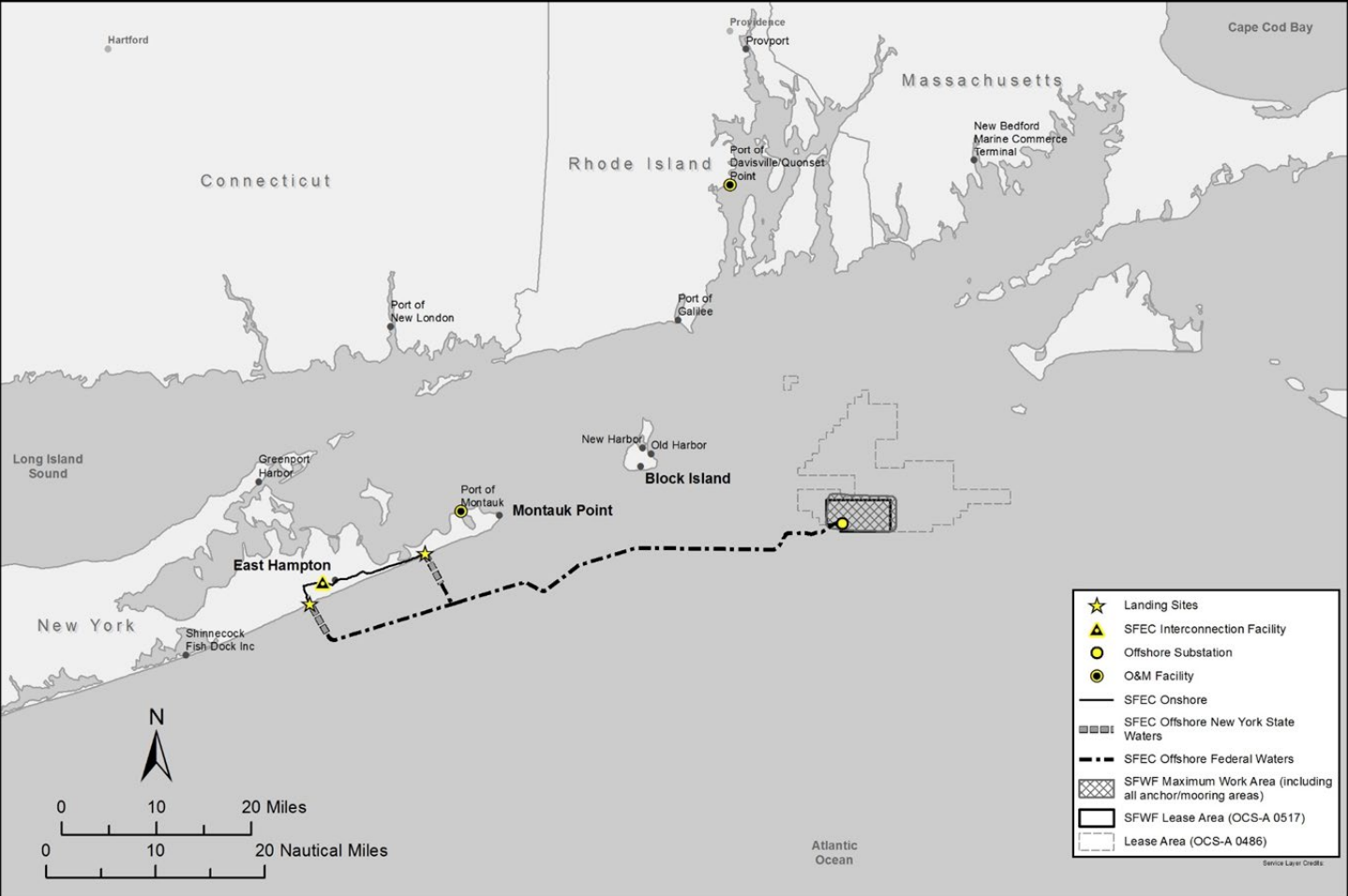The South Fork Wind project design will be reduced from 15 turbines to 12 under a modified construction and operations plan, the federal Bureau of Ocean Energy Management confirmed in a record of decision Wednesday.
The agency adopted a “habitat alternative” turbine layout as its preferred plan out of the environmental impact study for the project, planned for 35 miles east of Montauk, N.Y., by wind developers Ørsted and Eversource.
Originally leased by Rhode Island wind power pioneers Deepwater Wind – the startup later absorbed by Ørsted – the South Fork tract is about 19 miles southeast of Deepwater Wind’s five-turbine, 30-megawatt Block Island Wind Farm, the first U.S. offshore commercial wind installation.
On track to start construction in January 2022, South Fork with about 130 MW capacity would follow the 800 MW Vineyard Wind project underway off southern Massachusetts.
Named for the southeast corner of Long Island, the South Fork project is touted as one answer to the island’s growing power supply needs and New York State’s goal of 9,000 MW or renewable energy.
Skeptics dispute the project’s real power potential, and New York and Rhode Island commercial fishermen are fighting against the disruption looming for their industry.
BOEM’s early outlines for wind power areas off southern New England excluded much of Cox’s Ledge, productive and heavily fished grounds, and the agency’s preference now for the habitat alternative recognizes the value of keeping turbine construction off what fisheries experts call complex bottom that host many fish species.
Still, BOEM’s summary of its decision recognizes major effects to the region’s fishing industry.
The agency foresees “negligible to major adverse construction and installation, O&M, and conceptual decommissioning impacts to commercial fisheries and for-hire recreational fishing due to increased port congestion; changes to fishing access, primarily through reduced fishing opportunity when construction activities are occurring; damage to or loss of fishing gear; and impacts on the catch due to changes in target species abundance or availability during construction activities.”
Turbine foundations and their rock armoring for scour protection may give recreational fishing new artificial reef habitat to attract fish, the report notes.
But for the fishing fleet generally, “overall cumulative adverse impacts would be major.”
Offshore wind advocates say the record of decision is another boost to building up a U.S. industry.
“Last week, Vineyard Wind held its groundbreaking ceremony, and this week, the South Fork Wind announcement enhances investor trust in the certainty of the U.S. offshore wind market,” said Liz Burdock, president and CEO of the industry group Business Network for Offshore Wind. “This is critical to capturing local economic benefits associated with the offshore wind industry.”
The Responsible Offshore Development Alliance, a coalition of fishing groups, said BOEM is continuing to misjudge the effect of southern New England wind developments on their industry.
“South Fork is now the second project BOEM has approved without taking reasonable measures to protect seafood producers and the marine environment off of New England. Issuing this decision on the eve of a holiday dedicated to community and appreciation of local harvest is especially ironic,” the group said in a statement Wednesday evening.
“The government has opted to give free license to introduce the world's largest hammers (pile drivers) and fast-moving ships for the next 30 years in an area the state of Rhode Island recognizes as 'one of the few remaining places in Rhode Island Sound that Atlantic cod are found at all life stages,' and which hosts the largest aggregations of highly endangered North Atlantic right whales,” the group said.
“Again the agencies have failed to require any meaningful mitigation measures that could have reduced these impacts, such as time of year restrictions for cod spawning, replacements for longstanding biological surveys that will be prevented from operating, or safe navigation corridors.”
New York labor and industry groups see South Fork as the first in a wave of offshore opportunities for their members.
“Offshore wind is regarded as Labor's seed in growing an equitable economy that extends well beyond the shoreline,” said Matthew Aracich, president of the Building and Construction Trades Council of Nassau and Suffolk Counties, AFL-CIO. “BOEM’s resolution on South Fork Wind sets the stage for a period of prosperity that spans an entire generation."







